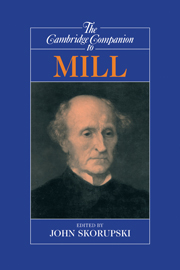Book contents
- Frontmatter
- Introduction
- 1 Mill on language and logic
- 2 Mill, mathematics, and the naturalist tradition
- 3 Mill on induction and scientific method
- 4 Mill, phenomenalism, and the self
- 5 Mill on religion
- 6 Mill on psychology and the moral sciences
- 7 Mill's utilitarianism
- 8 Mill's political economy
- 9 Civilization and culture as moral concepts
- 10 Democracy, socialism, and the working classes
- 11 The subjection of women
- 12 Mill and the Classical world
- 13 The reception and early reputation of Mill's political thought
- 14 Mill in a liberal landscape
- Guide to further reading
- Bibliography
- Index
12 - Mill and the Classical world
Published online by Cambridge University Press: 28 May 2006
- Frontmatter
- Introduction
- 1 Mill on language and logic
- 2 Mill, mathematics, and the naturalist tradition
- 3 Mill on induction and scientific method
- 4 Mill, phenomenalism, and the self
- 5 Mill on religion
- 6 Mill on psychology and the moral sciences
- 7 Mill's utilitarianism
- 8 Mill's political economy
- 9 Civilization and culture as moral concepts
- 10 Democracy, socialism, and the working classes
- 11 The subjection of women
- 12 Mill and the Classical world
- 13 The reception and early reputation of Mill's political thought
- 14 Mill in a liberal landscape
- Guide to further reading
- Bibliography
- Index
Summary
MILL'S CLASSICAL INTERESTS
Mill began learning Greek at the age of three and Latin at eight. From about the age of twelve his Greek and Latin reading focussed on works “such as were worth studying, not for the language merely, but also for the thoughts”. He mentions especially Demosthenes, Tacitus, Juvenal, and Quintillian. His father laid special emphasis on Plato. Throughout his literary career, from his discussion of Sedgwick on education in Cambridge to his own rectorial address on education in St Andrews, Mill retained a keen interest in Classical studies and their place in education. Moreover, he took an active part in encouraging the study of Classical antiquity among readers who were beyond the years of formal education. In 1834-35 he published 'Notes on some of the More Popular Dialogues of Plato' - really an abbreviated translationcum- paraphrase. In 1840 he reviewed two publications on Plato. In 1846 and 1853 he reviewed two sections of the multi-volume history of Greece by his friend and (with some qualifications) ally, George Grote, and in 1866 and 1873 he reviewed Grote's works on Plato and Aristotle.
- Type
- Chapter
- Information
- The Cambridge Companion to Mill , pp. 423 - 463Publisher: Cambridge University PressPrint publication year: 1998
- 13
- Cited by



